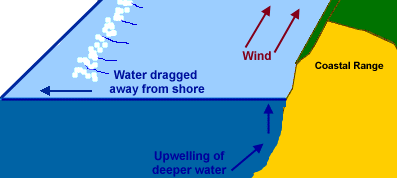Ekman Layer Historical Observations
First Observations:
The first observations of what became known as the Ekman
spiral were made by many people but not understood until a
Norwegian explorer and Oceanographer, Fridtjof Nansen,
observed the surface currents of the ocean were not the same
just below the surface as the wind, but angled slightly.
Icebergs in the norther hemisphere were observed to travel
at an angle 20 to 40 degrees to the right of the prevailing
winds. He took his findings to his student, Vagn Walfrid
Ekman, who determined that the combination of viscous drag
at a fluid boundary and the Coriolis effect were the cause.
Ekman's solution was presented in 1902 as his doctoral
thesis.
More Observations:
It was only until recently that sensitive enough
instrumentation was developed to measure the Ekman transport
in real geophysical systems such as the ocean surface.
Additionally, visualization of the Ekman layer at the
surface of the ocean is difficult because of the Ekman scale
height being on the order of only tens of meters and the
wind-driven surface waves interfering with measurements.
However, there are many visualizations in experiment that
demonstrate. The most famous of these is the convergence of
tea leaves (or other precipitant) in the bottom of stirred
tea.
Stirring the tea sets up a bulk rotation of tea fluid. Since
the Ekman layer is taller than the fluid depth, the Ekman
number is large and the transport force is strong. This
creates a converging horizontal flow at the bottom boundary
(of the teacup) and a diverging flow at the top fluid
boundary. The incompressibility of water demands that there
be vertical flows to keep continuity of fluid, thus there is
a strong upwelling in the middle of the teacup. Since the
tea leaves at the bottom of the teacup are heavy, they
collect at the middle at the bottom of the teacup. Many
think of this as a paradox, initially thinking that the
centrifugal effects should serve to push the tea leaves
radially outward. The key here is that Coriolis effects
dominate over centrifugal effects.
Additionally, the Ekman layer and associated Ekman pumping
is thought to be the driver of coastal upwelling and
downwelling. Wind following the coastline forces the fluid
in the Ekman layer as discussed in the derivation. In the
northern hemisphere, if the wind flow has the coast on its
left an upwelling occurs; a downwelling occurs when the wind
flow has the coast on its right. The opposite is true in the
southern hemisphere, e.g. the western coast of Peru. Here,
the wind blows north, with the coast on its right, inducing
an upwelling in the Ekman layer. Water flows upward along
the coast to replenish that taken by the Ekman flow bringing
with it fish, creating one of the most active fishing
locations in the world.
Upwelling and downwelling in the ocean is also exited by the
equatorial trade winds. In this geometry, the winds are
blowing either east or west which induces a transport of
warmer water toward the pole or a transport of cool water
away from the pole, respectively. This can affect and
contribute to the existence of ocean gyres, as observed by
Harald Sverdrup.
Many geophysical exhibitions of Ekman pumping are difficult
to see directly in real systems due to the presence of many
other phenomena associated with sheared flows. If the flow
is sufficient enough, as is often present in real-world
flows and experiment, turbulence can make observing the
Ekman spiral difficult and even serve to disrupt the Ekman
layer itself.
Table of Contents:
- Abstract
- Derivation and Mathematical Formulation
- Historical Observations (this page)
- Visualization and Experimental Observations
- Resources
